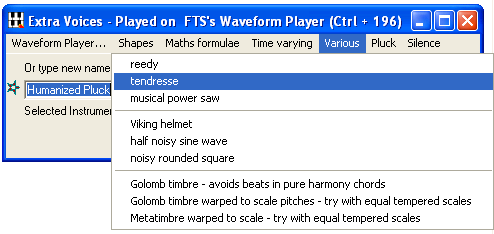Waveform Player
One of the many features that come as part of Fractal Tune Smithy
Intro
Use the new inbuilt waveform player as a source of new
pure harmonic timbre type sounds. It explores some
of the sounds you can make by repeating a short segment of the curve for any
mathematical formulae in various ways, which is an unusual approach in this field, so may give new sounds for composers.

This is particularly of interest for explorations of pure ratio harmonies, since the pure haromonic timbres can help bring out fine distinctions of just intonation. It is also a source of new exactly pitched sounds for general microtonal use.
top
Motivation
Voice, strings, and many instruments are close to pure harmonic timbres. If you look at them on an oscilloscope, you see a waveform that repeats exactly or almost exactly. An ideal mathematically pure harmonic timbre would repeat exactly.
So - why not see what happens if one makes a mathematically ideal pure harmonic timbre?
This player makes a start at exploring some of the sounds you can make by repeating a short segment of the curve for any mathematical formulae - not just the usual sine waves.
top
Techy details for the mathematically inclined
You can try segments of polynomials, Bessel functions, functions like sin(1/x) that go wild at the origin, and so on. By reflecting and inverting the curve - or by using end smoothing and adding an appropriate linear or quadratic term any segment of a curve can be made to repeat exactly and smoothly, with the same area to either side of the zero line as is needed for a sound wave.
top
Accuracy
It's other speciality is that it plays the frequencies very precisely, using double precision floating point throughout. This means the pitches are accurate to about fourteen decimal places or so. Single precision floating point such as is more commonly used in FM synths etc. would be fine actually, this level of precision is mainly of technical interest. But either way it is at any rate far more accurate in pitch than a sample player would be likely to be, so can be a useful alternative to your soundcard or Giga / GPO etc when you want to explore particularly precisely pitched sounds.
You can also render the audio directly to a file as it plays, if you want to bypass the soundcard and save the waveform exactly as it was made (the soundcard often distorts the waveform - apart from adding noise that is - because there is going to be some limit to its frequency response, however high it is, in the conversion from digital to analogue and then back to digital for the recording).
To find this feature, go to its Audio Settings window and look for Echo to audio file.
top
Ease of use
It is very easy to use. You don't need to know how the maths works, as the preset instruments can just be selected from a menu. Also you can tweak the instruments can tweak by varying parameters - and if you have some basic maths awareness, you can also make new waves yourself.
top
To continue reading about Tune Smithy, go on to the Calculator
The program comes with a Free Test drive with all the features completely unlocked (start the test drive at any time):
Download Tune Smithy
top
|